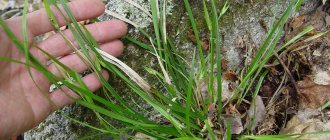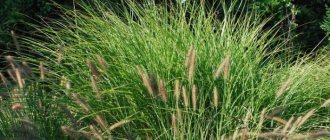Many people like lilac, because this shrub with fragrant lush inflorescences does not require special care, but at the same time it can become a worthy decoration for any summer cottage. When lilacs bloom, it is impossible to pass by the fragrant bush without paying attention to it.
But there are situations when lilacs, for some unknown reason, stop blooming. In this article we will try to figure out why it does not bloom and what work needs to be done for inflorescences to appear.
Types and varieties of lilac - names and photos.
Today, more than 30 species of plants from the lilac genus have been studied and described, but a unified scientific classification still does not exist.
The most famous include the following varieties: Common lilac (lat. Syringa vulgaris) is a medium-sized shrub, sometimes growing into a fairly tall tree. The height of ordinary lilac can reach 7 meters. Very fragrant brushes up to 25 cm in size are collected from small simple flowers of white or light purple color. Based on this species, breeders have created many new varieties of lilac with pyramidal, round, cone-shaped and even cylindrical inflorescences. Varieties of common lilac:
Lilac Beauty of Moscow is a medium-sized spreading bush up to 4 m high with ovate-elongated foliage. The vertical inflorescences of lilac consist of large, pinkish-white, double flowers with a barely noticeable purple bloom. At the end of the flowering period, lilac flowers turn white.
Lilac Aucubafolia (Aucubaefolia) is a tall, upright shrub with light green leaves, on which small stripes and spots of yellow are visible. Lilac buds are pink-purple in color, and the large double flowers that open are bluish-purple.
Lilac Sensation is a lilac variety of medium height (up to 3 meters), the leaves are dark green. The flowers are dark lilac with a white edge.
Meyer's lilac (lat. Syringa meyeri) is a miniature upright shrub no more than one and a half meters high, with broadly elliptical foliage of a dark green color, with a edging along the veins on the underside, lighter side. Small (up to 10 cm) lilac inflorescences, consisting of small flowers, are painted in a light lilac-pink color. Based on this plant, the following varieties of lilac were bred:
Red Pixie lilac is a low-growing, late-blooming (until mid-June) variety with small, pleasantly fragrant red-violet flowers that turn pink as they age.
Lilac Palibin is a remontant dwarf lilac with erect inflorescences of mauve color with a pale lilac tint. The first time lilac blooms is in late May - early June, the second flowering is observed in mid-August.
Shaggy lilac (lat. Syringa villosa) is an erect, medium-sized shrub with wide, elliptical, pubescent foliage, about 15 cm long. Lilac inflorescences, almost 24 cm in size, consist of medium-sized pink-purple flowers.
Persian lilac (lat. Syringa persica) - the species was obtained by crossing small-cut and Afghan lilacs. The height of lilac is about 3.5 m, the leaves are light green and pointed in shape. Light purple flowers of medium size are collected in inflorescences with an unusual aroma. However, there are forms with white and red brushes.
Drooping lilac (lat. Syringa reflexa) is a medium-sized upright shrub with a crown height of no more than 3 meters and elongated dark green ovoid leaves with a light edge along the veins. The flowers of this type of lilac are small (up to 10 mm), two-colored on the outside (pink with a reddish tint) and almost white inside, forming gracefully hanging racemes.
Hungarian lilac (lat. Syringa josikaea) is an upright growing bush about 4 meters high, with densely branched shoots and dark shiny foliage. The inflorescences consist of small, long-tubular flowers of lilac color and are almost odorless. Lilacs begin to bloom at the end of May.
Broad-leaved lilac (Syringa oblata) is a plant with a high spreading spherical crown up to 3 m, which can develop in the form of a shrub or tree. The broad, heart-shaped foliage is about 10 cm long and 7 cm wide. Conical inflorescences up to 12 cm in size are colored pale purple or violet-lilac. This type of lilac begins to bloom early and delights with flowers from late April to early May.
Hyacinth lilac (lat. Syringa hyacinthiflora) is a medium-sized bush with heart-shaped, spiky leaves that turn purple-brown in autumn. Small loose clusters consist of rather small flowers of a bluish-purple color. Several varieties have been created based on this type of lilac:
The lilac variety Buffon is a medium-sized, profusely flowering plant with large light purple, pleasantly fragrant flowers, collected in large (up to 20 cm) inflorescences.
The Churchill lilac variety is an early flowering variety with large red-violet buds. When open, lilac flowers are colored silver-purple with a delicate pink tint.
Lilac after flowering
Young trees need to cover the trunk with foliage or peat with a layer of 10 centimeters. If the lilac was damaged in winter, then after frost it is necessary to cut off such parts.
Types and varieties of lilacs with photos and names
- White lilac – color white or purple. In winter it sheds its leaves green, and its leaves appear early. When blooming, you need to water generously. At other times this should only be done when it is very hot.
White lilac bush - Lilac Liega - flowering continues for a long time with double inflorescences. Height 2-3 meters. Long lasting when cut, more flowers in lots of sun.
Liega - Lilac pearl - 20-centimeter inflorescences are painted with lilac-pink and pinkish-white colors. There is a pearlescent sheen. When the flowering period ends, the petals turn white.
Lilac pearl - Lilac bride is a very delicate variety. The pinkish-white petals form a touching picture.
Lilac bride - Night lilac has wide oval-shaped petals. Painted with dark purple paints. The smell is unusual.
Unsuitable soil
Common lilac.
growing common lilac. caring for common lilac It should be remembered that each variety of lilac grows only in a certain soil, since breeders grow unique varieties in greenhouse conditions, giving them various fertilizers. And then it turns out that they cannot grow and bloom in ordinary soil, unlike ordinary varieties, which do not care what the composition of the soil is.
Then the likelihood that the lilac will bloom will increase.
If the soil is waterlogged and swampy, then it will be difficult for lilac to grow in it, since it is not a moisture-loving shrub.
And heavy clay soil will not suit it, since the roots will not be able to receive enough oxygen. The same can be said for acidic soil.
For ideal development of the shrub, the soil must have neutral acidity and moderate moisture. If the lilac is planted in an area that is too windy, then there is a high probability that it will not bloom, since it will feel very uncomfortable in this place.
Lilac propagation by cuttings, layering and seeds.
How to plant mulberries in Siberia and what year does it begin to bear fruit after planting?
Lilacs can be propagated using layering and cuttings. Under natural conditions and in nurseries, propagation by seeds is used.
Lilac propagation by cuttings.
Lilacs take root very difficult, so to propagate lilacs from cuttings, the following conditions must be met:
- The cuttings are harvested immediately after the end of lilac flowering or during it;
- Cut material early in the morning from young plants, choosing shoots in the middle of the crown. For cuttings, take non-lignified branches of medium thickness with 2-3 nodes and short internodes.
The leaves on the lower node of the cut lilac cutting are removed, after which an oblique cut is made on it with a sharp knife. The leaf blades at the second and third nodes are shortened to half, and the top is cut at a right angle directly above the last node. The lower part of the prepared planting material is immersed in a solution of root growth stimulator for at least 16 hours.
Rooting lilac cuttings is best done in greenhouses or in a cutting box placed in partial shade. To speed up root germination, planting material can be covered with cut water bottles with a capacity of at least 5 liters. Before planting lilacs, you need to wash the oblique cut of the cutting with clean water. The best substrate for growing cuttings is a mixture of peat and sand in a 1:1 ratio. Sand can be partially replaced with perlite. The prepared substrate is used to fill the planting container with a layer of up to 20 cm, after which another 5 cm of river sand is poured onto the soil. To prevent infection of lilac cuttings with fungal diseases, the substrate is treated with a solution of a fungicide such as Fundazol or Maxim. To accelerate the growth of the root system, the lower part of the planting material should again be treated with Kornevin.
Then they start planting lilacs. To do this, make a depression in the sand into which the cutting is placed so that its lower edge does not reach the mixture. There should be a distance between the cuttings to prevent their leaves from touching. Afterwards, the cuttings are sprayed with water from a spray bottle, covered with cut bottles and shaded.
The sand should not dry out, so the planting material must be sprayed with water several times a day to ensure 100% humidity, necessary for better germination. To prevent the formation of mold, spraying should be carried out with a weak solution of potassium permanganate once every seven days.
Roots on cuttings appear 45-60 days after planting. After this, you need to ventilate them every evening, and over time, completely open the seedling. If the roots sprouted in mid-autumn, the cuttings are left to overwinter in a container. Timely rooted cuttings are planted in a bright place with light, slightly acidic soils. In order for the plants to successfully overwinter, the seedlings need to be covered with spruce branches. With the arrival of spring, the insulation is removed. Such a seedling blooms in about 5 years.
Lilac propagation by layering.
You can propagate lilacs by layering. To do this, young shoots up to 20 cm high that begin to lignify are tied at the base with wire, preferably copper. After this, the pulled shoot is hilled to a height of at least half its length. As the shoot grows, soil is added to the place of the constriction. Before the onset of cold weather, shoots with regrown roots are cut off from the main bush and sent for growing.
Lilac propagation by seeds.
Lilacs can also be propagated by seeds. Lilac seeds collected in the fall in damp, humid weather germinate best. These seed pods are dried at room temperature for several days. To improve germination, seeds are stratified. To do this, they are mixed with sand in a ratio of 1:3, slightly moistened and, poured into containers, placed in the refrigerator for two months. All this time you need to make sure that the sand does not dry out.
Lilac seeds
Lilacs are planted in the second ten days of March. Well-steamed garden soil is used as a substrate. Seed the seeds to a depth of no more than 15 mm. Watering is carried out using a sprinkler. Depending on the type, it can take from 14 days to 3 months before lilac shoots appear. After this, after 12-14 days, the seedlings are picked, keeping the distance between them within 4 cm. With the onset of stable heat, the seedlings are planted in a permanent place. You can carry out pre-winter sowing in specially prepared beds. The ground should be slightly frozen. In the spring, such seedlings are picked and sent for growing. In the first growing season, the soil under the seedlings is not fertilized. The root shoots of two-year-old plants are removed, and underdeveloped lilac bushes are pruned “to a stump,” preserving several pairs of buds on it.
What year does lilac bloom after planting?
The year in which lilacs bloom after planting depends on when it was planted and in what way. In any case, this will not happen next spring. It is even more foolish to expect inflorescences after planting lilacs in the spring. The timing of the first flowering is usually two to three years after planting. Lilacs bloom after planting, sometimes even after 5 years.
Any of the lilac varieties blooms very beautifully. Lilacs look great on a trunk (trunk without side shoots). By the way, standard lilacs are easier to form. But dwarf lilac blooms twice a year.
How to make lilacs bloom
Why doesn't Kalanchoe bloom: what to do and how to make it bloom? care tips
If you planted a seedling on your site, and it successfully took root, grew, but did not begin to bloom, you should reconsider the methods of caring for the shrub. An ordinary garden crop takes root well in any area, but for varietal seedlings it is necessary to create special conditions.
Let's try to figure out what actions need to be taken to make lilacs bloom.
Care
First of all, you should choose the right site for planting. It should be well illuminated by the sun in the first half of the day, and moderate shading is allowed in the second. Also, the site should be protected from drafts and strong gusts of wind.
The soil should be light and crumbly: peat or sand. If your site has heavy soils, add a special lightweight substrate for this crop to the planting hole.
After planting, the shrub is cared for as follows (Figure 2):
- Water the bush regularly, avoiding waterlogging of the soil, and remove weeds;
- In early spring, feed the crop with organic fertilizers;
- At the beginning of May it is necessary to fertilize with mineral nitrogen fertilizers.
Figure 2. Caring for crops in a summer cottage
In addition, it is necessary to mulch the soil around the bush to prevent the evaporation of moisture from the soil and stop the growth of weeds.
From the video you will learn how to properly care for lilacs so that they bloom regularly.
Watering
Despite the fact that the plant does not tolerate high soil humidity and practically does not take root in wetlands, watering the plant should be regular.
In hot weather, it is necessary to water not only the soil around the bush, but also spray the leaves. The water should not be too cold, and it is better to carry out the procedure itself in the morning or evening so that burns do not appear on the leaves.
Every year it is necessary to water with lime mortar: several grams of lime powder are dissolved in a bucket of water and poured under the bush. This will help stimulate flowering.
How to prune lilacs to bloom
Pruning plays an important role in stimulating flowering. It cannot be carried out in the fall, since removing excess shoots will stop the formation of buds, and the shrub may not bloom next year (Figure 3).
Figure 3. Shrub pruning diagram
The bush is rejuvenated every three years. To do this, cut out all the branches that thicken the crown or grow inside the bush. It is also necessary to remove all old and dry shoots. The cut areas should be covered with garden varnish or oil paint to prevent infection from getting inside the wound.
Pests and diseases
Lilac, like other garden plants, is susceptible to diseases and pests. To prevent this, preventive spraying is carried out with Bordeaux mixture or special chemicals against insects.
The most common plant diseases and pests are (Figure 4):
- Fungi provoke the formation of spots of different shapes and sizes on the leaves. Subsequently, the leaves and inflorescences begin to fall off. In order to prevent the spread of fungi, all damaged leaves and shoots must be collected and burned, the bush must be fed with potassium fertilizers and sprayed with copper preparations.
- Late blight leads to the fact that the buds on the bush do not open, and the bark becomes covered with brown spots. The leaves begin to curl and the inflorescences dry out. All affected parts of the plant are removed and burned, after which they are sprayed with Bordeaux mixture.
- Nematodes lead to the death of roots, as a result of which the bush begins to gradually shed its leaves and dry out. To eliminate the pest, it is necessary to cut off and burn all damaged parts and treat the soil with special chemicals against the pest. For prevention, you can plant decorative onions near the bush.
Figure 4. Main diseases and pests of the crop: 1 - fungal diseases, 2 - late blight, 3 - nematodes
Preventing diseases is much easier than treating them, so you should promptly remove all weeds, regularly fertilize the soil and carry out preventive treatment with copper preparations and Bordeaux mixture.
Planting lilacs
Few people know that lilacs are related to olive trees. This plant tolerates both frost and drought; such a beautiful and unpretentious ornamental plant should be looked for. As a rule, lilacs are planted in the second half of August or the first week of September. However, this does not apply to all its varieties. So, planting lilacs in April is possible if it is a climbing lilac.
It is important to observe several conditions for proper planting of lilacs:
- In the place where lilacs are planted, the soil should be slightly alkaline, or better yet, neutral, and have excellent permeability.
- Lilac will bloom only if it gets enough sunlight in the first half of the day. Lack of light slows down the growth and reduces the flowering of lilacs.
- It is advisable to protect the place where the lilac will grow from the wind.
- The ideal place to plant lilac bushes is on a slope from the southwest.
- When planting, organic fertilizers should be added to the soil, and later mineral fertilizers.
- Planting lilacs in the ground in spring or autumn is best done in cloudy weather or in the evening.
- The holes for planting lilac seedlings in the spring should have steep walls and a size corresponding to the condition of the soil (the higher its fertility, the larger the holes).
- Planting lilacs with a closed root system, according to experienced gardeners, is much simpler than planting lilacs with an open root system.
- When planting lilac seedlings in the spring, flowering will not occur in the same year, which is why it is better to plant lilacs in the fall.
- Planting lilacs from cuttings is a labor-intensive process, even the preparatory stage takes a lot of time. They are planted during the period of active flowering, and in the fall lilacs are planted in open ground, and caring for the seedlings necessarily includes protecting the root system from frost.
How long does it take for lilacs to bloom?
The duration of flowering of the shrub also depends on the variety and climatic conditions. Usually the entire lilac bush blooms in about 9-10 days. The flowering period of one panicle is 14-18 days. In this case, one single flower will bloom for about 9-12 days. Shrubs with inflorescences in lighter colors (pink, pink-white and white) bloom earlier. Varieties with more saturated purple and lilac shades bloom later.
The total flowering time of the entire bush is 25-30 days. Most popular varieties bloom for no more than 40 days. Varieties that begin to bloom towards the end of May stop this process at the end of June. Terry varieties of lilac bloom a little longer.
Mature shrubs have a longer flowering period than young ones. In hot weather, the duration of lilac flowering is shortened as the inflorescences burn and dry out.
Caring for lilacs during flowering
With the arrival of spring, flowers bloom on lilacs and begin to emit a luxurious aroma. Unfortunately, insects still appear. You have to remove the cockchafers yourself. In addition to this work, you also need to remove approximately 60% of the branches that bear flowers.
This will help in more successful future flowering and the formation of new stems. If you pick a bouquet, then to extend its life you need to cut the shoot in half. By picking lilacs in the morning, you also help the bouquet stay in the vase longer. When everything has bloomed, you should cut off all the inflorescences.
When does the lilac month bloom?
In central Russia, lilacs bloom in May or June. Its inflorescences look like small panicles that have a pyramidal shape. The length of the brushes is usually from ten to twenty centimeters. They contain a large number of small flowers, which have a very strong aroma and, in most cases, bright color. They are located in inflorescences in small paired bunches containing from three to five flowers.
This plant is very unpretentious and does not require special care. It can grow on any type of soil, but it is best if the soil is loamy and richly enriched with humus. This shrub develops well and can actively bloom in places that are most suitable for it. If you prepare the soil before planting and add the necessary minerals and organic matter, you can achieve maximum effect and increase the flowering time of lilacs.
Why is lilac growing slowly?
Lilac flowering may also be delayed for another reason: acidic soil. Lilac, although not a high-maintenance shrub, can wait years for flowering on acidic soils! “Ash” the bush (that is, sprinkle ash under the lilacs), add rotted compost.
Interesting materials:
What is the freshness zone in a Samsung refrigerator? What is a proverb? What is a switch? What is heavier than one liter of fluff or one liter of iron? Is there something bubbling in the refrigerator? Some kind of spelling analysis? What is more valuable than pink salmon or chum salmon? What's wrong with Dorokhov's face? What do the mountaineers have in their pockets? What do mosses have instead of roots?
Problems with lilac diseases
If you plant a tree correctly, find a suitable place for it, and use planting technology, problems may still arise. One of the annoying problems with plants is pests. If you notice any strange external changes in the lilac, such as dryness and weakness of the tree, dried out foliage, a change in the color of the leaves to yellow, then you can be sure that the bush is affected by diseases or pests.
If in a young lilac that has already bloomed, you notice a deviation from the norm in the flowers themselves; they are poorly developed and look weak, then next year the bush may not bloom at all if measures are not taken in time. The branches that have been affected must be cut off and burned along with the leaves, and the shrub itself must be treated with a remedy against pests and diseases. If you ignore problems with lilacs, they will soon simply dry out.
Why lilacs don’t bloom for a long time: the main reasons
Numerous factors can lead to the absence of the long-awaited flowering of fragrant lilacs. If you take them into account and take note before planting a tree, you can avoid many problems.
- When there are no inflorescences on a tree in the first year after planting, this may be evidence that the tree was planted in the shade. The fact is that lack of lighting, especially in the spring-summer season, negatively affects its flowering period. Lilac is considered a light-loving plant, constantly requiring a lot of heat and light. Therefore, if the bush is planted near other trees or in close proximity to the house, preventing the penetration of light, the lilac may never bloom.
- Incorrect technology for planting seedlings can lead to the fact that the shrub does not bloom even in its fifth year. Inexperienced gardeners may make the following mistakes during the planting process: excessive deepening of the roots of the shrub and lack of drainage during planting.
- Like most trees and shrubs, lilac needs systematic pruning and processing. If you forget to do this, then the young branches will not be able to fully develop the next year, which, in turn, will lead to the fact that the inflorescences will not be fully formed.
- Too compassionate gardeners mistakenly believe that the more nitrogen fertilizers the shrub receives, the better it will be for it, and that this will lead to abundant flowering next year. An excess of nitrogen in the soil is one of the common reasons why shrubs do not bloom.
- Although lilac is an unpretentious plant, it still requires the right choice of soil for planting. A common reason why lilacs refuse to produce inflorescences is inappropriate soil composition. Particularly unfavorable are swampy soil and places where groundwater is located relatively close to the surface. It should be remembered that lilac really does not like waterlogged soil, as well as dense soil, since the roots of the plant in such conditions can quickly suffocate or rot.
- No less common reasons for the lack of long-awaited flowering of the bush are various lilac diseases. Lilacs will not be able to bloom even if all planting rules have been followed. Infection of a bush with pests or diseases can lead to the fact that the bush will not bloom either next year or ten years later. Therefore, if the slightest deviations are detected, appropriate measures should be taken immediately: treatment with special means or pruning of infected branches. In general, it is best to prevent the disease and carry out prevention immediately after the shrub has been planted.
- Another reason why lilacs may not bloom is planting too close to other plants and trees. The fact is that the root system of most trees is so developed that it prevents the further development of the bush.
If at least one of the above factors is present, then the lilac most likely will not be able to bloom after planting. And if this happens, it may take more than one year .
Lilac - description and photo
In most cases, lilac is a shrub with many upright or spreading trunks up to 5-7 meters high; less often the plant has the outlines characteristic of a tree.
The lilac bush is abundantly covered with foliage, which is located on opposite branches and stays on them until late autumn. Depending on the type of lilac, the leaf blades can be simple with a smooth edge, ovoid, oval or elongated with a pointed nose, as well as feathery and complexly dissected.
Lilac leaves are light or dark green in color, and their length can reach 12 cm.
The funnel-shaped lilac flowers are quite small with four petals. They form racemose or paniculate inflorescences. The number of flowers on one lilac bush during flowering can reach 18,000 pieces.
The color of lilac can be pink and purple, white and purple, blue and violet. In most types of lilac, an admixture of another color is added to the main monochromatic color. The aroma of lilac is very delicate, subtle and has a calming effect.
The elongated lilac fruits are a two-leaf capsule containing several seeds with wings.
Care
It is believed that lilac is one of the most unpretentious plants. However, we all understand that everyone needs care without exception.
We want to admire the lush and fragrant color, which means we have to give our attention and care in return. The most important thing in care is regular loosening of the soil.
Especially when the lilac is young. After all, loosening promotes good access of moisture and air to the soil. Lilacs need to be protected from frost in the spring and from drought in the summer.
Watering
This plant needs to be watered in the first half of summer. If the weather during this period is not rainy, watering should be abundant and deep. Approximately up to thirty liters per square meter. In the second half of summer, you can water lilacs in case of severe drought. Excess moisture during this period can lead to re-awakening of the kidneys.
Fertilizer
Proper nutrition is also an important condition for the full growth of lilacs. This plant needs almost all the basic chemical elements
Among them are nitrogen, phosphorus, calcium, sulfur, iron, iodine, fluorine, zinc, and this is not the whole list. The bush needs to be fertilized when it reaches two years of age. Fertilize three times a year. The first fertilizing is done immediately after the snow has melted. The second and third with an interval of twenty days. The ideal material for feeding is humus or rotted manure.
Pests and diseases
Let's take a look at the most common diseases:
- mosaic;
- calcium spot;
- necrosis;
- verticillium wilt;
- late blight
To easily recognize these sores, let's take a look at their description. The mosaic manifests itself in the appearance of small yellow spots on lilac leaves. With severe damage, the leaves curl and the plant eventually dries out. Calcium spot is a viral disease. It is transmitted during cutting and during the grafting process. Appears in the form of various patterns on the leaves. Necrosis is a very common bacterial disease. It appears in the form of wilted leaves and tops of lilacs. Particularly common in cold and wet years.
Verticillium wilt is a fungal disease. In the presence of this disease, leaves turn yellow and wither. The disease is very complex and incurable. Affected bushes are destroyed by burning. Late blight is indicated by dried and blackened buds. Brown spots are visible on the bark and leaves. This disease is treated by spraying with Bordeaux mixture.
Lilac is a symbol of spring with a heady aroma. Represents the awakening of nature after a long sleep. Enjoying its aroma and admiring the lush color, we firmly believe in the beginning of a new and happy stage in our lives. Let it be so and only so.
Growing shrubs
The main thing in properly growing lilacs is proper care for them. It includes: fertilizer, care, watering, properly selected mail and a place for planting.
Fertilizer and care
Many gardeners claim that this plant is the most unpretentious, but it is still necessary to follow some rules for caring for shrubs. The most important thing before the lilac flowering period is to fertilize the soil in which it grows. The best time of year for this is early spring and late autumn
The most important thing in care is timely loosening of the soil, this is especially important when the bush is still young. It is important to protect the plant from frost and insulate the trunks and roots with special materials
Organization of watering
You need to moisten the soil before the buds begin to bloom and when the lilacs bloom.
It is also important to water the plant in the first half of summer, since at this time the rainy season has not yet begun. If the temperature is high in summer and the soil becomes dry, it is necessary to water abundantly.
And also monitor the condition of the plant in which month the lilac blooms, since during this period it needs as many useful components as possible.
Not all of us know exactly how this shrub got to our latitudes. He came to us from Persia. On the Balkan Peninsula this is a very popular plant that grows in almost any area. Translated from Greek, lilac is a reed pipe. Every year the mountainous slopes are covered with colorful flowers and a wonderful aroma wafts in the air.
People associate several well-known signs with this plant. For example, it is believed that if you find a flower with five petals among a large number of inflorescences, it can bring happiness. But from another sign it follows that if you come across a flower with three petals, then this is a sign of failure.
But no matter how hard many try to find such flowers, most often they come across simple ones with four petals, which is characteristic of lilac bushes.
In the European part, this shrub has become known since the sixteenth century. At this time, it was at the peak of popularity in Constantinople and grew in almost every garden. Over the years, breeders have developed dozens of lilac varieties and made them suitable for growing in any climate.
Common lilac is an ornamental shrub often planted in gardens. The plant is characterized by abundant flowering and a wonderful aroma. The description and secrets of growing a beautiful flowering shrub are given below. Common lilac belongs to the olive family (Oleaceae).
Caring for lilacs in the garden
Getting beautiful lilacs in your area is not as difficult as it might seem at first glance. You also don't need much care for it. She can easily grow on her own. The ideal option would be if systematic watering is provided. This must be done from the first days of summer until the 15th of July. Approximately 2.5-3 buckets should be used for 1 bush as the soil dries out.
During the season, you should loosen the soil around the trunk 3-4 times, going 4-7 centimeters underground. It is important to remove weeds on time. During the last month of summer and the first month of autumn, watering is recommended only during a long drought. In just 5-6 years you will be able to admire the pretty flowers.
During the first two years of the tree's life, some nitrogen should be added. When the plant is 2 years old, from that moment on each specimen must be fertilized with ammonium nitrate (65-80 grams) or urea (50-60 grams). Gardeners with extensive experience advise feeding this tree with organic mixtures. For example, you can use 10-30 liters of manure, diluted according to a system of 1 part manure to 5 parts water. You should also add the nutrient mixture there.
Every 2-3 years, potassium and phosphorus are selected for feeding. For one mature specimen, 0.035-0.040 kg of double superphosphate and 0.030-0.035 kg of potassium nitrate are calculated. The capsules are deepened 6-8 centimeters around the trunk and watered. But a mixture of wood ash is considered the best option. 200 grams should be diluted with 8 liters of water.
Lilac diseases and pests: combating them, treatment, description and photo.
Lilacs are rarely affected by pests and various diseases, but this fragrant beauty also has “health problems.” The most dangerous and common diseases and pests of lilac are the following:
Bacterial (nectria) necrosis of lilac: The disease usually begins to progress in early to mid-August. Signs of garden lilac disease are, first of all, a change in the color of the leaves from green to ash-gray, and young shoots of the bush and branches become brown or brown. Control measures: thinning lilac plantings for optimal ventilation, timely control of insect pests, as well as cutting and burning all damaged parts of the bush or completely removing a heavily infected plant by uprooting.
Powdery mildew on lilac (caused by the fungi Microsphaera syringae, Microsphaera penicillata f. syringae). It quickly affects both young seedlings and adult bushes. The lilac leaves turn white, and a powdery coating of gray-whitish color becomes noticeable on them. The disease occurs especially often during dry and excessively hot summers. Control measures: infected parts of the lilac must be removed and burned. In early spring, you need to add bleach to the soil (100 g per sq.m.) and carefully dig the soil, trying not to disturb the roots of the bush.
Verticillium wilt of lilac. This disease is provoked by the fungus Verticillium albo-atrum; the lilac leaves curl, brown or rusty brown spots appear on them, the leaves dry, wither and fall off. The lilac dries out (usually from the top) and quickly dies. Treatment: treating the bush during the growing season with a solution of soda ash and laundry soap in a ratio of 100 grams (1:1) per 15 liters of water, spraying with Abiga-Peak, as well as burning fallen leaves and damaged growth.
- The lilac leaf mite (lat. Eriophyes saalasi) is a tiny insect with an appetite that sucks the juices from the underside of the leaves, as a result of which the lilac leaves turn brown and dry out. Large populations of the pest can destroy a healthy and large bush in a couple of weeks. Control measures: apply phosphorus-potassium fertilizers to the soil around the tree trunk, prune thickened branches, treat the bushes with copper or iron sulfate, burn the fallen leaves before the onset of winter.
- Lilac bud mite (lat. Eriophyes loewi). The entire life of this pest passes in the buds of the lilac bush, where it feeds on the juices of the plant and overwinters there. As a result, the buds become deformed, weak, underdeveloped leaves and shoots appear from them; as a result, the lilac does not bloom and often dies in the second or third year. Treatment: treatment of the bush with copper sulfate as soon as the frosts have passed (before the buds open), removal of dry leaves and root shoots, autumn digging of the soil around the bush no less than a full bayonet of a shovel with turning over the layers.
- Lilac leaf miner is an insect pest that quickly attacks the leaves of a plant. Initially, lilac leaves are covered with dark brown spots (mines), after a while they curl into a tube, becoming as if burned. Lilac bushes affected by moths stop blooming and die after 1-2 years. Control measures: deep digging of the soil with careful turning of the soil under the bush before frosts and in the spring, pruning the affected leaves and then burning them. An already infected plant must be treated with Bordeaux mixture, Baktofit or Fitosporin-M, spraying generously on the foliage.
In any case, pay attention to the planting material: seedlings should have a well-formed root system, glossy buds with tightly fitting scales and healthy green leaves with a smooth matte or slightly glossy surface











